Methods
Detections of acoustically-tagged animals are recorded by a network of 120 VR2W receivers deployed in multiple arrays across a 100 nm stretch of coast, predominantly within the Territorial Sea (i.e., within 12 nm of shore). Receiver arrays off Charleston, SC (orange dots) were established in December 2013, but were expanded in April 2015 to include two artificial reefs in the southern part of the state plus a deeper site off Charleston, SC to compare sturgeon detections with the Gray's Reef National Marine Sanctuary (yellow circle). The southernmost receivers (green dots) were established in spring 2014 and are managed by the Coastal Resources Division of the GADNR.
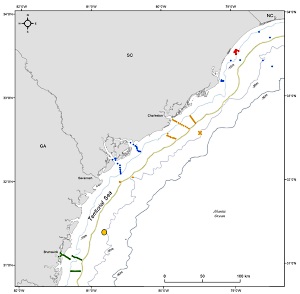
Near the southern terminus of South Carolina, the Inshore Fisheries Group (blue dots) has managed a receiver array off shore of and near the entrance to Port Royal Sound since spring 2014, with a second shipping channel array added to St. Helena Sound in summer 2016. Receiver coverage between Winyah Bay and Little River, SC began in summer 2016 with the addition of shipping channel entrance receivers for Winyah Bay, artificial reef receivers in Long Bay, and pre- and post-sand mining for beach re-nourishment at Garden City (red dots). Within these receiver arrays, two receiver deployment techniques are used.
Surface-mounted Receivers
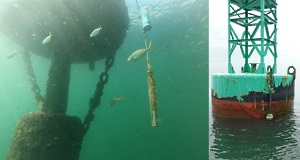
In five shipping channel entrances, a Memorandum of Understanding was established with the U.S. Coast Guard Seventh District to enable acoustic receivers to be attached to Aids to Navigation (ATON's). At these locations, 45 receivers were deployed roughly 10 feet below the water surface. A variety of rigging materials were investigated across groups, but with central themes of (a) adequate chaffing protection to minimize rigging severance at the lifting bale eye, (b) exterior PVC pipe to 'push' rigging away from the ATON, (c) terminal weight to keep the rigging plum, and (d) minimal rigging length to reduce the probability of snagging on ATON infrastructure. This technique enabled acoustic receivers to be accessed and uploaded from the surface.
Seafloor-mounted receivers
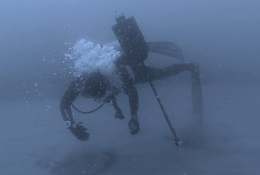
The remaining 45 receivers were deployed between two and six feet above the seafloor and were retrieved by scientific SCUBA divers. Deployment closest to the seafloor resulted from direct attachment of receivers to four or five foot iron screw anchors (3/4 in. diameter, single helix), half of which projected above the seafloor; this deployment technique was reserved for areas where the potential for interference from commercial shrimp trawlers was thought to be minimal. In areas associated with trawling, three foot iron screw anchors (3/4 in. diameter, double helix) were deployed flush to the seafloor and a rope lanyard attached was attached to the head of the screw anchor using a stainless steel bolt; receivers were housed in 8 in. diameter bullet floats secured to the other end of the lanyard. As detailed in the first three 6-month progress reports, much of the first half of this study was devoted to the development and refinement of an appropriate 'receiver buoy' design.
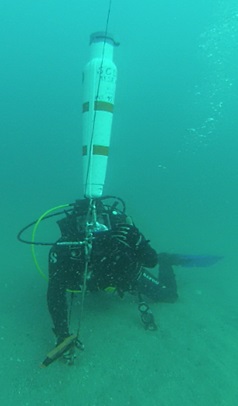
Because seafloor-mounted receivers were not marked by floats at the water surface, a thin diameter line is sent to the surface after installing each seafloor-mounted receiver to establish the location 40 to 90 feet overhead. During subsequent visits to each site, great care is taken to ensure that the diver descent line is deployed as close to this mark as possible, to minimize underwater search effort in visibility conditions that ranges from < 3 to sometimes > 40 feet. Upon locating the receiver, divers examine the screw anchor and all connections for wear, tighten fittings and make repairs, and/or remove fouling organisms from critical components as needed. Divers then worked together to snip a plastic zip tie and remove the deployed acoustic receiver from a PVC housing before replacing it with a receiver prepared for the new deployment prior to the dive. Divers then return safely to the surface, and multiple dive teams repeated this process in an alternating order each field day.
Mobile Receivers
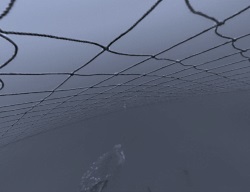
Between 2013 and 2015, opportunistic mobile acoustic monitoring was also conducted by deploying acoustic receivers during on-going research surveys that use trawl nets, chevron traps, and longline/drum line gear. These deployments occurred across multiple research studies conducted by the SCDNR Marine Resources Division between Florida and North Carolina. However, this phase of data collection was abandoned after fall 2015 in order to re-allocate acoustic receivers to support increased fixed location monitoring that began in spring 2016.
